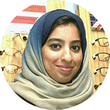- OT
- Life in practice
- Practitioner stories
- “No-one is born discriminatory”
Time to speak
“No-one is born discriminatory”
Optometrist, Shamina Asif, shares her experiences of discrimination while working as a locum optometrist – and her vision for a fairer future


Shamina Asif
07 July 2022
Through the Time to speak series, OT profiles how discrimination in the workplace is affecting eye care professionals. If you would be willing to share your experience, please contact [email protected]
Locum optometrist and Dudley Local Optical Committee chair, Shamina Asif: “I felt like saying ‘Just give me a chance’”
As a locum, sometimes I feel I am treated differently if I am working in a new store where the staff are not used to working with people from Black, Asian and minority ethnic (BAME) backgrounds. I have also noticed that since I started wearing a headscarf I have been treated differently compared to in the past, when I did not wear one. When I go to a new practice, I feel like the staff are assessing whether I can speak fluent English and whether I am competent enough in performing my job. It is only by the end of the day that they like me as an optometrist – but by that point it is time for me to leave.
I have received many comments from patients asking how long I have been in the country or enquiring about my qualifications before I start the sight test. Once, when I went to a small village in the countryside to cover for the day a patient said, ‘What are all these coloured people doing here?’ I have had patients rebook appointments as soon as they see that I am going to be doing their sight test and I felt like saying ‘Just give me a chance.’
Eventually, through education, I believe we can tackle this
When I work, I just want to be able to do my job competently and need the full support of staff. When I am having to tackle issues like this it makes work more difficult. You are trying to get used to equipment and a new environment so the last thing you want is to be judged by the way you look. If my locum friends tell me that they didn’t enjoy their day and had a bad experience at certain stores, or I am covering a store where the patients do not normally see an optometrist from a BAME background, I have to carefully consider booking locum days there.
As an optical professional I would like to see a better understanding and appreciation of the diversity within optics as this would benefit the whole community. If we have a workforce that are happy and comfortable in their environment, then this will improve productivity. If optical professionals feel uncomfortable because of some of their protected characteristics, their performance suffers and ultimately this means the best service is not being provided to our patients.
If staff can see the behaviour of their colleagues or patients is not appropriate and discriminatory in nature, then there should be someone in an organisation that they can confidentially speak to, so that issues can be addressed. The organisation needs to have a policy in place.
I think all optical staff need to have training around equality and diversity. It is also important to educate staff about the demographics within our workforce. They need to know that a lot more of the optometrists now qualifying are from a BAME background.We need to have equality, diversity, and inclusion officers present within organisations
No-one is born discriminatory; this is a learnt behaviour, and, in some cases, it is because we are fearful of the unknown. Eventually, through education, I believe we can tackle this.
We need to have equality, diversity, and inclusion officers present within organisations like the AOP, LOCSU, and the College of Optometrists. Large multiples should also think about such appointments.
I also feel that we need more BAME representation on boards, as currently there is a mismatch. Far more BAME optometrists are out working in the hospitals and the community compared to those in positions where policies and strategies are being developed. If we had better representation, then this may reduce discrimination.
I have had organisations say, ‘well we have those from BAME backgrounds, and we have a lot of women working for us.’ But what you find is that the boards consist of white women and Asian men, and they think they are doing a great job in terms of diversity when the Asian women are not represented. This is very important to consider as it is those two characteristics combined, the ‘intersection,’ that needs appropriate representation. Intersectionality can apply to age, religion, sexual orientation, and disability.
In terms of diversity at higher levels, it has improved since I qualified 15 years ago. I believe there is hope for future optometrists. The situation will get better as we have open discussions about this within optometry. There are now advocates within optometry for tackling discrimination and organisations are realising the benefit that diversity brings.
Finally, it is important to note though that most of my successes and progression within optometry have been through the support of Caucasian men, so it is important to realise that it is a minority of people that have certain perceptions of people from BAME backgrounds.
AOP support
- The AOP has launched its 100% Respect campaign, which calls on all those working in the profession to make a pledge to unite against all forms of discrimination
- Our employment team can advise you on all forms of discrimination and discuss your options with you. If you are experiencing discrimination or know someone who is, you can contact the employment team or read our guidance for employees.
- As told to Selina Powell.

Comments (1)
You must be logged in to join the discussion. Log in
Anonymous20 July 2022
Excellent article
Report Like 217